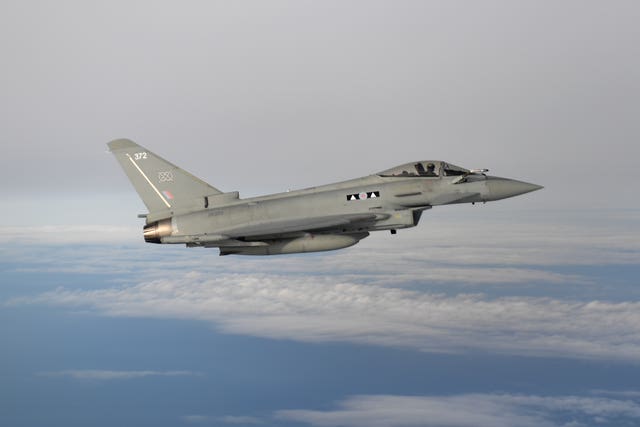
The supersonic F-35B Lightning II is the cutting-edge aircraft which has taken part in active British operations for the first time.
With six of the jets currently based at RAF Akrotiri in Cyprus, they will spend the next week continuing to fly in support of UK Typhoons as part of efforts to target the remains of Islamic State (IS).
Here are some facts and figures behind the cutting-edge F-35 warplanes, Eurofighter Typhoon jets and the wider Operation Shader.
– Operation Shader
In 2014, Islamic State blitzed across vast swathes of Syria, seizing Raqqa, before spreading into northern and western Iraq, capturing Mosul and even advancing to the edges of Baghdad. Since then, the US-led 80-member global coalition has worked to destroy the extremists – seeing Mosul liberated in July 2017 and Raqqa in October 2017 as a result of the efforts – with Iraq declaring the country liberated in December 2017.
Britain’s contribution, known as Operation Shader, has involved air strikes on key IS targets, the training of local forces and the provision of military equipment.
RAF jets alongside Reaper drones have carried out more than 1,700 strikes using 4,300 weapons, as well as surveillance and reconnaissance missions since efforts to eradicate the group began. By March this year, the group which formerly controlled a territory the size of the UK, was reduced to a sliver of land in Baghouz before their territorial defeat was declared.
– F-35

The jet measures 15.6 metres (51.2ft) in overall length, has a wingspan of 10.7 metres (35ft) and a height of 4.36 metres (14.3ft). It has a top speed of 1.6 Mach or 1,200mph and a Max G rating of 7g. Maximum thrust tops 40,000lbs and the jet has a range of 900 nautical miles.
Lockheed Martin, the American company building the jets, describes its stealth capabilities as “unprecedented”. Its airframe design, advanced materials and other features make it “virtually undetectable to enemy radar”.
The F-35B can launch from land and sea. Britain’s jets will take off from and land on the behemoth aircraft carrier HMS Queen Elizabeth in the autumn. Some of the air-to-surface weapons and ordnance the jets can carry include the AIM-120 AMRAAM and Paveway IV precision-guided bombs.
– Eurofighter Typhoon

With a maximum speed of Mach 1.8, it was first deployed in combat in Libya in 2011 and four years later became a key feature in Operation Shader. The jets measure 15.9 metres (52.4ft) in length, are 5.2 metres (17.4ft) in height and have a wingspan of 11 metres (36.4ft).
There are currently eight of the jets based at RAF Akrotiri, used in the air campaign against IS in Iraq and Syria. The jet is used for Britain’s Quick Reaction Alert squadrons based at RAF Lossiemouth, Scotland, and RAF Coningsby, Lincolnshire, with a presence also in the Falkland Islands.
Typhoons are armed with an internal 27mm Mauser cannon, plus ASRAAM air-to-air missiles, as well as Enhanced Paveway II and Paveway IV. Earlier this year, the jet began carrying and using Storm Shadow and Brimstone bombs, as well as Meteor air-to-air missiles.


Comments: Our rules
We want our comments to be a lively and valuable part of our community - a place where readers can debate and engage with the most important local issues. The ability to comment on our stories is a privilege, not a right, however, and that privilege may be withdrawn if it is abused or misused.
Please report any comments that break our rules.
Read the rules here